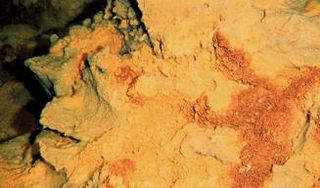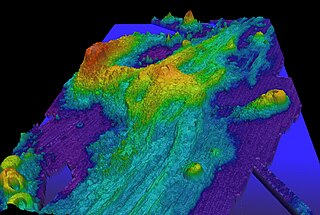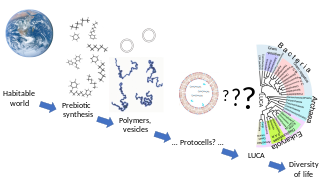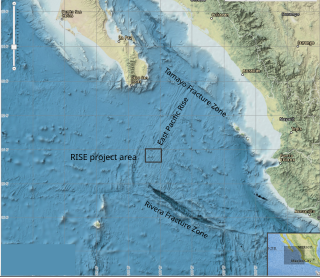Related Research Articles

Astrobiology is a scientific field within the life and environmental sciences that studies the origins, early evolution, distribution, and future of life in the universe by investigating its deterministic conditions and contingent events. As a discipline, astrobiology is founded on the premise that life may exist beyond Earth.

An extremophile is an organism that is able to live in extreme environments, i.e. environments with conditions approaching or expanding the limits of what known life can adapt to, such as extreme temperature, radiation, salinity, or pH level.

A hot spring, hydrothermal spring, or geothermal spring is a spring produced by the emergence of geothermally heated groundwater onto the surface of the Earth. The groundwater is heated either by shallow bodies of magma or by circulation through faults to hot rock deep in the Earth's crust. In either case, the ultimate source of the heat is the radioactive decay of naturally occurring radioactive elements in the Earth's mantle, the layer beneath the crust.

Enceladus is the sixth-largest moon of Saturn. It is about 500 kilometers in diameter, about a tenth of that of Saturn's largest moon, Titan. Enceladus is mostly covered by fresh, clean ice, making it one of the most reflective bodies of the Solar System. Consequently, its surface temperature at noon only reaches −198 °C, far colder than a light-absorbing body would be. Despite its small size, Enceladus has a wide range of surface features, ranging from old, heavily cratered regions to young, tectonically deformed terrain.

A hydrothermal vent is a fissure on the seabed from which geothermally heated water discharges. They are commonly found near volcanically active places, areas where tectonic plates are moving apart at mid-ocean ridges, ocean basins, and hotspots. Hydrothermal deposits are rocks and mineral ore deposits formed by the action of hydrothermal vents.

Kamaʻehuakanaloa Seamount is an active submarine volcano about 22 mi (35 km) off the southeast coast of the island of Hawaii. The top of the seamount is about 3,200 ft (975 m) below sea level. This seamount is on the flank of Mauna Loa, the largest shield volcano on Earth. Kamaʻehuakanaloa is the newest volcano in the Hawaiian–Emperor seamount chain, a string of volcanoes that stretches about 3,900 mi (6,200 km) northwest of Kamaʻehuakanaloa. Unlike most active volcanoes in the Pacific Ocean that make up the active plate margins on the Pacific Ring of Fire, Kamaʻehuakanaloa and the other volcanoes of the Hawaiian–Emperor seamount chain are hotspot volcanoes and formed well away from the nearest plate boundary. Volcanoes in the Hawaiian Islands arise from the Hawaii hotspot, and as the youngest volcano in the chain, Kamaʻehuakanaloa is the only Hawaiian volcano in the deep submarine preshield stage of development.

Karl Otto Stetter is a German microbiologist and authority on astrobiology. He is an expert on microbial life at high temperatures.

The hydrogen cycle consists of hydrogen exchanges between biotic (living) and abiotic (non-living) sources and sinks of hydrogen-containing compounds.

Axial Seamount is a seamount, submarine volcano, and underwater shield volcano in the Pacific Ocean, located on the Juan de Fuca Ridge, approximately 480 km (298 mi) west of Cannon Beach, Oregon. Standing 1,100 m (3,609 ft) high, Axial Seamount is the youngest volcano and current eruptive center of the Cobb–Eickelberg Seamount chain. Located at the center of both a geological hotspot and a mid-ocean ridge, the seamount is geologically complex, and its origins are still poorly understood. Axial Seamount is set on a long, low-lying plateau, with two large rift zones trending 50 km (31 mi) to the northeast and southwest of its center. The volcano features an unusual rectangular caldera, and its flanks are pockmarked by fissures, vents, sheet flows, and pit craters up to 100 m (328 ft) deep; its geology is further complicated by its intersection with several smaller seamounts surrounding it.

In biology, abiogenesis or the origin of life is the natural process by which life has arisen from non-living matter, such as simple organic compounds. The prevailing scientific hypothesis is that the transition from non-living to living entities on Earth was not a single event, but a process of increasing complexity involving the formation of a habitable planet, the prebiotic synthesis of organic molecules, molecular self-replication, self-assembly, autocatalysis, and the emergence of cell membranes. Many proposals have been made for different stages of the process.

The Endeavour Hydrothermal Vents are a group of hydrothermal vents in the north-eastern Pacific Ocean, located 260 kilometres (160 mi) southwest of Vancouver Island, British Columbia, Canada. The vent field lies 2,250 metres (7,380 ft) below sea level on the northern Endeavour segment of the Juan de Fuca Ridge. In 1982, dredged sulfide samples were recovered from the area covered in small tube worms and prompted a return to the vent field in August 1984, where the active vent field was confirmed by HOV Alvin on leg 10 of cruise AII-112.

Enceladus Life Finder (ELF) is a proposed astrobiology mission concept for a NASA spacecraft intended to assess the habitability of the internal aquatic ocean of Enceladus, which is Saturn's sixth-largest moon and seemingly similar in chemical makeup to comets. The spaceprobe would orbit Saturn and fly through Enceladus's geyser-like plumes multiple times. It would be powered by energy supplied from solar panels on the spacecraft.
Journey to Enceladus and Titan (JET) is an astrobiology mission concept to assess the habitability potential of Enceladus and Titan, moons of Saturn.
Life Investigation For Enceladus (LIFE) was a proposed astrobiology mission concept that would capture icy particles from Saturn's moon Enceladus and return them to Earth, where they could be studied in detail for signs of life such as biomolecules.
The Virtual Planetary Laboratory (VPL) is a virtual institute based at the University of Washington that studies how to detect exoplanetary habitability and their potential biosignatures. First formed in 2001, the VPL is part of the NASA Astrobiology Institute (NAI) and connects more than fifty researchers at twenty institutions together in an interdisciplinary effort. VPL is also part of the Nexus for Exoplanet System Science (NExSS) network, with principal investigator Victoria Meadows leading the NExSS VPL team.
Methanocaldococcussp. FS406-22 is an archaea in the genus Methanocaldococcus. It is an anaerobic, piezophilic, diazotrophic, hyperthermophilic marine archaeon. This strain is notable for fixing nitrogen at the highest known temperature of nitrogen fixers recorded to date. The 16S rRNA gene of Methanocaldococcus sp. FS406-22, is almost 100% similar to that of Methanocaldococcus jannaschii, a non-nitrogen fixer.

The earliest known life forms on Earth are believed to be fossilized microorganisms found in hydrothermal vent precipitates, considered to be about 3.42 billion years old. The earliest time for the origin of life on Earth is at least 3.77 billion years ago, possibly as early as 4.28 billion years ago—not long after the oceans formed 4.5 billion years ago, and after the formation of the Earth 4.54 billion years ago. The earliest direct evidence of life on Earth is from microfossils of microorganisms permineralized in 3.465-billion-year-old Australian Apex chert rocks, although the validity of these microfossils is debated.

The hydrothermal vent microbial community includes all unicellular organisms that live and reproduce in a chemically distinct area around hydrothermal vents. These include organisms in the microbial mat, free floating cells, or bacteria in an endosymbiotic relationship with animals. Chemolithoautotrophic bacteria derive nutrients and energy from the geological activity at Hydrothermal vents to fix carbon into organic forms. Viruses are also a part of the hydrothermal vent microbial community and their influence on the microbial ecology in these ecosystems is a burgeoning field of research.

The RISE Project (Rivera Submersible Experiments) was a 1979 international marine research project which mapped and investigated seafloor spreading in the Pacific Ocean, at the crest of the East Pacific Rise (EPR) at 21° north latitude. Using a deep sea submersible (ALVIN) to search for hydrothermal activity at depths around 2600 meters, the project discovered a series of vents emitting dark mineral particles at extremely high temperatures which gave rise to the popular name, "black smokers". Biologic communities found at 21° N vents, based on chemosynthesis and similar to those found at the Galapagos spreading center, established that these communities are not unique. Discovery of a deep-sea ecosystem not based on sunlight spurred theories of the origin of life on Earth.
Rachel Haymon is a marine geologist known for her work linking geological and biological processes occurring at deep-sea hydrothermal vents. In 2005 she was elected a fellow of the Geological Society of America.
References
- 1 2 Sullivan, Florence (2017-03-07). "Celebrating Hydrothermal Vents!". Geospatial Ecology of Marine Megafauna Laboratory. Retrieved 2021-07-09.
- ↑ "Prof. John Baross Featured in New NASA Calendar! – uwastrobiology" . Retrieved 2021-07-09.
- ↑ Baross, John A.; Lilley, Marvin D.; Gordon, Louis I. (1982). "Is the CH4, H2 and CO venting from submarine hydrothermal systems produced by thermophilic bacteria?". Nature. 298 (5872): 366–368. Bibcode:1982Natur.298..366B. doi:10.1038/298366a0. ISSN 1476-4687. S2CID 128415368.
- ↑ Baross, John A.; Deming, Jody W. (1983). "Growth of 'black smoker' bacteria at temperatures of at least 250 °C". Nature. 303 (5916): 423–426. Bibcode:1983Natur.303..423B. doi:10.1038/303423a0. ISSN 1476-4687. S2CID 7584772.
- ↑ Cone, Joseph (1991). Fire Under the Sea: The Discovery of the Most Extraordinary Environment on Earth--volcanic Hot Springs on the Ocean Floor. Morrow. pp. 196–197. ISBN 0688098347.
- ↑ Opatkiewicz, Andrew D.; Butterfield, David A.; Baross, John A. (2009-11-05). "Individual hydrothermal vents at Axial Seamount harbor distinct subseafloor microbial communities". FEMS Microbiology Ecology. 70 (3): 413–424. doi: 10.1111/j.1574-6941.2009.00747.x . ISSN 0168-6496. PMID 19796141.
- ↑ Summit, Melanie; Baross, John A. (1998-12-01). "Thermophilic subseafloor microorganisms from the 1996 North Gorda Ridge eruption". Deep Sea Research Part II: Topical Studies in Oceanography. 45 (12): 2751–2766. Bibcode:1998DSRII..45.2751S. doi:10.1016/S0967-0645(98)00092-7. ISSN 0967-0645.
- ↑ Holden, James F.; Takai, Ken; Summit, Melanie; Bolton, Sheryl; Zyskowski, Jamie; Baross, John A. (2001-06-01). "Diversity among three novel groups of hyperthermophilic deep-sea Thermococcus species from three sites in the northeastern Pacific Ocean". FEMS Microbiology Ecology. 36 (1): 51–60. doi: 10.1111/j.1574-6941.2001.tb00825.x . ISSN 0168-6496. PMID 11377773.
- ↑ Kelley, D. S. (2005-03-04). "A Serpentinite-Hosted Ecosystem: The Lost City Hydrothermal Field". Science. 307 (5714): 1428–1434. Bibcode:2005Sci...307.1428K. doi:10.1126/science.1102556. ISSN 0036-8075. PMID 15746419. S2CID 42382974.
- ↑ Raymer, Steve; Findley, Rowe (1981). "Mount St. Helens Aftermath: The Mountain That Was--and Will Be". National Geographic. Vol. 160, no. 6.
{{cite news}}: CS1 maint: date and year (link) - ↑ Dahm, Clifford N.; Baross, John A.; Ward, Amelia K.; Lilley, Marvin D.; Sedell, James R. (1983). "Initial Effects of the Mount St. Helens Eruption on Nitrogen Cycle and Related Chemical Processes in Ryan Lake". Applied and Environmental Microbiology. 45 (5): 1633–1645. Bibcode:1983ApEnM..45.1633D. doi:10.1128/AEM.45.5.1633-1645.1983. ISSN 0099-2240. PMC 242510 . PMID 16346298.
- ↑ Baross, John A.; Dahm, Clifford N.; Ward, Amelia K.; Lilley, Marvin D.; Sedell, James R. (1982). "Initial microbiological response in lakes to the Mt St Helens eruption". Nature. 296 (5852): 49–52. Bibcode:1982Natur.296...49B. doi:10.1038/296049a0. ISSN 1476-4687. S2CID 4334003.
- ↑ Baross, John A. (2007). "The Limits of Organic Life in Planetary Systems". The National Academies Press. doi:10.17226/11919. ISBN 978-0-309-10484-5.
- ↑ Corliss, J. B.; Baross, Ja; Hoffman, Se (1981-01-01). "An Hypothesis Concerning the Relationships Between Submarine Hot Springs and the Origin of Life on Earth". Oceanologica Acta. ISSN 0399-1784.
- ↑ Baross, John A.; Hoffman, Sarah E. (1985). "Submarine hydrothermal vents and associated gradient environments as sites for the origin and evolution of life". Origins of Life and Evolution of the Biosphere. 15 (4): 327–345. Bibcode:1985OrLi...15..327B. doi:10.1007/BF01808177. ISSN 1573-0875. S2CID 4613918.
- ↑ Helmreich, Stefan (2009). Alien Ocean: Anthropological Voyages in Microbial Seas. University of California Press. pp. 79–80. ISBN 9780520942608.
- ↑ Baross, John A.; Martin, William F. (2015). "The Ribofilm as a Concept for Life's Origins". Cell. 162 (1): 13–15. doi: 10.1016/j.cell.2015.06.038 . ISSN 0092-8674. PMID 26140586. S2CID 4229280.
- ↑ Glein, Christopher R.; Baross, John A.; Waite, J. Hunter (2015). "The pH of Enceladus' ocean". Geochimica et Cosmochimica Acta. 162: 202–219. arXiv: 1502.01946 . Bibcode:2015GeCoA.162..202G. doi:10.1016/j.gca.2015.04.017. ISSN 0016-7037. S2CID 119262254.
- ↑ Baross, J.A. (2020), "The Environmental Roots of the Origin of Life", Planetary Astrobiology, Bibcode:2020plas.book...71B
- ↑ Zimmer, Carl (2007-07-06). "Expanded Search for Extraterrestrial Life Urged". The New York Times. ISSN 0362-4331 . Retrieved 2020-08-01.
- ↑ Planets and life : the emerging science of astrobiology. Sullivan, Woodruff Turner., Baross, John A. Cambridge: Cambridge University Press. 2007. ISBN 978-0-521-82421-7. OCLC 144222457.
{{cite book}}: CS1 maint: others (link) - ↑ "John Baross". College of the Environment. Retrieved 2021-07-22.
- ↑ "Ocean census uncovers 'new world' of marine microbe life". phys.org. April 10, 2010. Retrieved 2021-07-22.
- ↑ Delaney, John R.; Kelley, Deborah S.; Mathez, Edmond A.; Yoerger, Dana R.; Baross, John; Schrenk, Matt O.; Tivey, Margaret K.; Kaye, Jonathan; Robigou, Veronique (2001). ""Edifice Rex" Sulfide Recovery Project: Analysis of submarine hydrothermal, microbial habitat". Eos, Transactions American Geophysical Union. 82 (6): 67–73. Bibcode:2001EOSTr..82...67D. doi: 10.1029/01EO00041 . ISSN 2324-9250.
- ↑ "Prof. John Baross Featured in New NASA Calendar! – uwastrobiology" . Retrieved 2022-02-07.